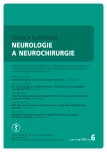Structure of Care in Neurorehabilitation
Authors:
M. Lippertová-Grünerová 1,2
Authors place of work:
LF Univerzity Kolín nad Rýnem, ANR Bonn
1; Klinika rehabilitačního lékařství 1. LF UK a VFN v Praze
2
Published in the journal:
Cesk Slov Neurol N 2012; 75/108(6): 689-693
Category:
Přehledný referát
Summary
The number of patients who are severely brain damaged, constantly growing, especially due to the growing number of vehicles and the ever-increasing popularity of high-risk “extreme” sports in their free time. Number of such patients also increases due to the considerable progress both in urgent emergency care, as well as in medical intensive care. Patients with severe, previously fatal, brain damage often survive, but often with severe functional consequences. For ethical and medico-political reasons, is a fundamental requirement to achieve these patients after acute medical care the best possible quality of life and self-sufficiency that would allow them to once again find its place in society. In the Czech Republic for the future development of rehabilitation essential to develop a legally docked phase model of comprehensive neurorehabilitation. Comprehensive neurorehabilitation begins in the acute phase of the disease and continues in special centers until it is appropriate to implement therapy at home. A good example of how to organize the rehabilitation process, the so-called phase model of rehabilitation, which is practiced for many years in the Federal Republic of Germany. Phase model here has helped optimize the structure of rehabilitation services, and enable transparency rehabilitation process. Definitions, in which phase of rehabilitation the patient should be admitted, there are fixed and the inclusion of patients within each phase follows the Barthel Index. Is also determined by the length and intensity of treatment, according to which govern the height of the daily cost of rehabilitation of the patient. The main benefit of this model is the ability to start early rehabilitation, and in many cases during the acute phase of the disease. This ensures continuity and quality of rehabilitation process in terms of the rehabilitation chain.
Key words:
brain injury – structural concept of rehabilitation – complex neurorehabilitation
Zdroje
1. Kock C, Fuhrmann R. Neurologische Frührehabilitation – ein dringendes Erfordernis. Rehabilitation 1992; 31(4): 251–262.
2. Ackermann H, Hermann J. Neurologische Rehabilitation. Stuttgart: Verlag Thieme 2004.
3. Dettmers C. Update neurologische Rehabilitation. Bad Honnef: Hippocampus Verlag 2005.
4. Hömberg V. Neurologische Rehabilitation. Der Internist 2010; 51(10): 1248–1253.
5. Mayer K. Hirnverletzung und Hirnerkrankung. Notwendigkeit und Bedeutung der Frührehabilitation. Versicherungsmedizin 1993; 45(4): 135–137.
6. Voss A, von Wild K, Prosiegel M. Qualitätsmanagement in der neurologischen und neurochirurgischen Frührehabilitation. München: Zuckschwerdt Verlag 2000.
7. BAR. Bundesarbeitsgemeinschaft für Rehabilitation. In: Arbeitshilfe für die Rehabilitation von Schlaganfallpatienten. Schriftenreihe: Heft 4. Frankfurt am Main: Eigenverlag 1993.
8. Liebold D. Rehabilitationsrecht. Rechtsprobleme der Frührehabilitation – unter besonderer Bezugnahme auf das Phasenmodell der BAR bei neurologischer Rehabilitation schwerst Hirngeschädigter. ZMGR 2010; 1(5): 272.
9. Schmidt J. KTQ-Reha-Zertifizierung: Neurologisches Phasenmodell integrativ zertifiziert. Das Krankenhaus 2008; 100(10): 1055.
10. BAR. Bundesarbeitsgemeinschaft für Rehabilitation (Hrsg.). In: Empfehlungen zur Neurologischen Rehabilitation von Patienten mit schweren und schwersten Hirnschädigungen in den Phasen B und C. Frankfurt am Main: Eigenverlag 1995.
11. Schönle PW. Frühe Phasen der Rehabilitation: Differentielle Schweregrad-Beurteilung bei Patienten in der Phase B und C mit Hilfe des Frühreha-Barthel-Index (FRB). Neurologie Rehabilitation 1995; 2(1): 21–25.
12. VDR – Verband Deutscher Rentenversicherungsträger. Phaseneinteilung in der neurologischen Rehabilitation. Rehabilitation 1995; 34: 119–127.
13. Schupp W. Neurologische Rehabilitation. In: Delbrück H, Haupt E (eds). Rehabilitationsmedizin. München: Urban & Schwarzenberg 1996: 443–505.
14. Frommelt P, Grötzbach H. Neurorehabilitation, Grundlagen, Praxis, Dokumentation. Berlin: Blackwell Wissenschafts-Verlag 1999: 123–127.
15. Lippert-Grüner M. Neurorehabilitace. Praha: Galen 2005.
16. Rollnik JD, Janosch U. Current trends in the length of stay in neurological early rehabilitation. Dtsch Arztebl Int 2010; 107(16): 286–292.
17. Garner C, Jaksche HD, Cerny-Provaznikova R, Laub MC, Mallinger J, Ott-Tannenbaum B et al. Neurologische Rehabilitation in Bayern. Untersuchung zur Entwicklung der Aufnahmekapazitäten der Rehabilitationskliniken 1992 bis 1994. Nervenarzt 1995; 66(6): 462–464.
18. Freimüller M, Fheodoroff K. Neurorehabilitation nach Schlaganfall. Wiener medizinische Wochenschrift 2003; 153(1–2): 25–28.
19. Fuhrmann R, Liebig O. Frührehabilitation im Krankenhaus – Zeit für Strukturveränderungen. Rehabilitation 1999; 38(2): 65–71.
Štítky
Dětská neurologie Neurochirurgie NeurologieČlánek vyšel v časopise
Česká a slovenská neurologie a neurochirurgie

2012 Číslo 6
- Metamizol jako analgetikum první volby: kdy, pro koho, jak a proč?
- MUDr. Lenka Klimešová: Multioborová vizita může být klíčem k efektivnější perioperační léčbě chronické bolesti
- Nejčastější nežádoucí účinky venlafaxinu během terapie odeznívají
Nejčtenější v tomto čísle
- Epidemie roztroušené sklerózy ve světě?
- Spinální kongres
- Kortikální patologie u roztroušené sklerózy – morfologické, imunopatologické a klinické souvislosti
- Fázový model neurorehabilitace
